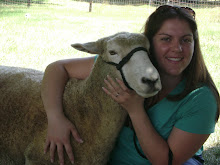Here's the before picture. He's not terribly dirty, just slightly dingy.

My sister and I would always use plain Ivory dish soap when we bathed our sheep for 4-H shows. To this day, whenever I smell Ivory dish soap I think of sheep. I didn't have any Ivory on hand yesterday, but I did have this shampoo I bought a few years back. It's Sullivan's Bright Lights bluing shampoo. It makes me think of old ladies. This soap is good for getting out yellow stains (from lanolin, manure, etc).

First step, wet down Calvin really well. Then, load him up with shampoo. I really recommend only doing one side at a time. The shampoo is pretty darn blue, and it works better if you wet it down a little after you put on the shampoo, so you can really scrub and work up a nice lather.

Here he is all lathered up. He wasn't too happy about the bath.

I rinsed him really well and took an "after" picture. See his tongue? I didn't realize it was out until I uploaded the picture. :-)
And here's one big difference with hair sheep. Hair!!
Hair sheep are different than "regular" sheep because hair sheep don't grow wool like the other sheep. They do get woolier over the winter, but they can shed out their wool/hair unlike most sheep. Most sheep have to get sheared once a year, which can be a hassle for sheep farmers. Wool can be hard to market, and prices can be so low you might only break even when you add in the costs of shearing and transportation. Hair sheep are very low maintenance. Because of their shedding coat, they don't need to be docked (docking is the removal of part of the tail when sheep are lambs). Docking is necessary in wool breeds because the wooly tail can trap urine and manure, causing fly strike. Flies lay eggs in the matted wool and manure and it causes a big mess. Not having to dock or shear saves a lot of time and money when you're raising sheep for profit. Hair sheep also tend to be more parasite resistant than other breeds. Some breeds of hair sheep include Katahdins, Dorpers, and Wiltshire Horn (aren't their horns lovely?), and St.Croix.
Back on track! Calvin had a little secret. A little brown spot on his left hind leg. Cute!






4 comments:
Wow!!! He looks awesome!! Did you tell him not to lay in the mud until Saturday?
I loved learning about hair sheep. Wow! The horns on that one breed... Wow!
What a gorgeous, soft, dazzlingly white sheep. I just want to hug him.
Interesting. I know so little about sheep. And I didn't realize all non hair sheep had the fly problem, just Merino.
How gorgeous he looks Katie!!! I know he knew he was quite the stud! You know so much and teach us so much with your blog. Thank you darling girl! Love you, Momma
Post a Comment